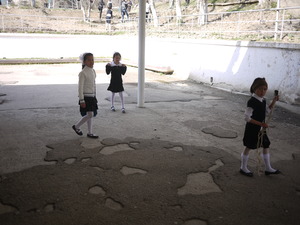|
|
Filtering Radiation Out of Water in Kyrgyzstan's Schools
Recent news reports that fish caught off the coast of Southern California contained radiation from Japan's damaged Fukushima
nuclear plant illustrates the great distances that some toxic substances can travel.
If radioactive particles (albeit small doses not enough to cause health concerns) can journey some 6,000 miles across the ocean, imagine what the town of Mailuu-Suu is like? When local children turn on the tap in their schools, they get water highly contaminated with radiation.
That is because Mailuu-Suu, in Kyrgyzstan, is located downstream from an old uranium mine with piles of toxic radioactive waste left exposed to the elements. Here, the potent pollutant only needs to travel a few miles to reach the town. Mailuu-Suu was on Blacksmith's first-ever list of world's worst polluted places. |
|
 For decades, piles of radioactive waste in Mailuu-Suu have been slowly leaching into the ground, contaminating the land and water, and sickening its 20,000 residents. For decades, piles of radioactive waste in Mailuu-Suu have been slowly leaching into the ground, contaminating the land and water, and sickening its 20,000 residents.
Moreover, with each earthquake or heavy rain, there is a danger that a catastrophic landslide will block the river next to the dumpsites, cause a flood, and spread radiation throughout large parts of Kygryzstan, Tajikistan and Uzbekistan. Data collected over 17 years show a clear correlation between cancer and congenital diseases with the level of life-threatening pollution in the town.
While the World Bank works on a long-term plan to protect the dumpsites from flooding, Blacksmith is reducing the risks to the most vulnerable residents by placing water filters in the town's hospital and schools. The cartridge in each filter is designed to remove toxins for three years. However in Mailuu-Suu, the extraordinary level of contamination renders the cartridges useless in just nine months.
This year, Blacksmith is returning to install filters in three additional schools and replace cartridges in older filters. Since 2008 when the program began, levels of radioactive elements in the water have decreased by between 48% and 65% in the hospital and schools where filters were installed. |
|
No comments:
Post a Comment